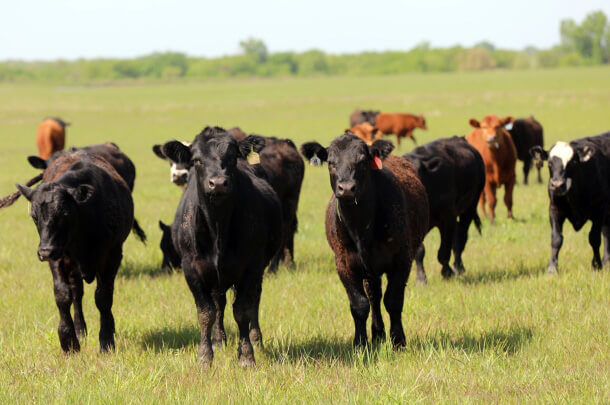Calf management and health at receiving
Calves entering a stocker operation could be newly weaned, commingled, long transported, dehydrated, and exposed to many different pathogens for the first time. Calves may not have been castrated, may still have horns, and many receiving calves could have inadequate vaccination histories. These calves must adapt to new diets, new environments, and establish new pecking orders. Working directly with cow-calf operations or order buyers to acquire preconditioned calves or to obtain the calves’ vaccination histories can help remove some of these stressors and reduce future problems.
Before the cattle arrive, it is important to create a plan for addressing any potential issues to help get those calves started correctly and ensure the success of the stocker enterprise. Many nutritionists recommend providing free access to good-quality, long-stemmed hay and water for the calves upon arrival. When entering a new environment, calves will naturally walk the perimeter; placing water tanks and portable bunks along the fence line will help them find water and starter feeds quickly. Hubbard Feeds® offers the StressGuard Starter System as well as CRYSTALYX® Brigade® and Battalion® barrels. These products were specifically formulated to replenish key electrolytes, stabilize the rumen, and support the immune system of calves after periods of increased stress.

Ideally, calves that have been transported should be allowed to rest for 24 hours before being processed. If possible, keep lot loads of calves in separate pens, as doing so can help mitigate the stresses of commingling and limit the potential pathogen load on the calves. Working calves in smaller groups during processing can also help decrease their stress. Processing will normally include ear-tagging, deworming, and vaccinating, as well as tipping horns and castrating all intact bulls. Consider utilizing implants to improve gains and feed conversion. When choosing an implant strategy, make sure that the implant is appropriate for grazing cattle, is correct for the sex of the calf, and will last for the entire time the cattle remain in the production phase. Feeding a coccidiostat and dewormer to calves after arrival is also recommended. Hubbard Feeds offers a line of medicated beef packs and ruminant deworming products that can easily be added to grain mixes or included directly in a total mixed ration.
Nutrition
When backgrounding calves over the winter, producers should grow calves with the goal of developing their frame, muscle, and immune system. Most operations will target average daily gains between 1.2 and 2.2 lbs./day. A key element of winter backgrounding is keeping feed costs low, and some forages that can help reduce winter feed costs include grazing upland pastures, winter pastures, and cornstalks. Additionally, using ammoniated straw and low-quality hays, as well as cost-effective byproducts, can help producers achieve their targeted average daily gains without breaking the bank. When spring approaches and these calves go to grass, the ration energy should transition so calves can achieve the gain that can be expected on spring pastures.
Once on grass, producers should consider the vitamin and mineral requirements of growing calves, as well as the use of ionophores and feed-through fly control. Ionophores consistently improve forage utilization and increase animal performance for pasture cattle. Hubbard Feeds offers Easylix® Rumensin Pressed Blocks, STOCKMASTER® Rangeland B1440 Mineral, and CRYSTALYX Iono-lyx B300, all of which are fortified with vitamins and minerals, and also contain either Rumensin® or Bovatec®. Additionally, CRYSTALYX Iono-lyx B300 contains 28 percent protein. This protein supplementation is important in growing calves and should be used on pastures with lower-quality grass and when pastures go dormant. CRYSTALYX low-moisture blocks do not contain salt, so it should be provided separately.
Flies keep cattle from grazing, rob average daily gains, and spread disease. Hubbard Feeds offers numerous feed-through fly control products in their STOCKMASTER, Blueprint®, and CRYSTALYX lines. These feed-through products stop fly larval growth and drastically reduce the number of mature flies that can negatively impact your herd.
The stocker calf enterprise is an important and necessary segment of the beef industry; it provides a constant supply of feeder cattle entering the feed yards, maximizes the quality of animals on feed, and adds value to young, weaned calves that fit the program. When calf health and nutrition are managed properly, stocker enterprise success is sure to follow.
--
James Gaspers, Ph.D., beef nutritionist, Hubbard Feeds






